How women’s football has grown in interest and investment over the years

Written by :
Matthew Hanssen

Reviewed by :
Heloisa Vasconcelos

The 2023 Women’s World Cup broke several records, including attendance, viewership and even goals. The growth in recent years has been notable, especially in terms of popularity, visibility and professional support, which has reflected cultural changes towards gender equality in sport.
We collected data from the last ten years of women’s soccer to measure this unstoppable growth, with a particular focus on the National Women’s Soccer League (NWSL), the national league in the United States.
Google News
Want to stay up to date with everything that happens in the world of sports betting? Access the news from Aposta Legal Brasil!
The growth of the NWSL
The NWSL has seen significant growth in interest and support for women’s soccer, with significant attendance figures growing over the years.
Since its inception in 2013, with a total attendance of nearly 400,000 people, the league has witnessed a consistent rise, reaching the 1 million fan mark in 2022, and a jump to 1.3 million in 2023 .
It is worth remembering that in 2020, due to the coronavirus pandemic, the stadiums were closed.
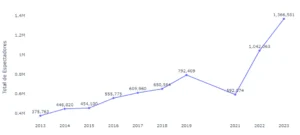
This dramatic increase can be attributed to a combination of factors, including investment in marketing, the quality of the game, and greater recognition of women’s football.
Average attendance has followed this trend, from 4,270 spectators per game in 2013 to 10,432 in 2023 (an increase of over 140%). The number of games per season has also grown, from 88 to 132 between 2013 and 2023, reflecting the expansion of the league and the increase in the number of participating teams.

Not only did the overall attendance average grow, but so did the individual team average. Below we have a look at the team with the highest and lowest attendance averages per year.
Of the ten seasons analyzed, Portland Thorns FC, from Portland, had the highest average in eight (Angel City FC, from Los Angeles, and San Diego Wave FC, from San Diego, achieved the highest numbers in 2022 and 2023, respectively). The number jumped from just over 13,000 people per game to almost 21,000. Similarly, the club with the lowest average attendance in the championship had an average of 1,664 fans in 2013.
In 2023, that number was three times higher, when the Chicago Red Stars averaged nearly 5,000 people per game.
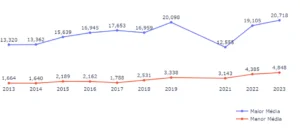
This data not only highlights the NWSL’s success in increasing club popularity, but also reflects growing support for women’s soccer in the United States.
Women’s football in the world
When looking at the average attendance figures for men’s and women’s soccer leagues, significant differences emerge. Liga MX and Major League Soccer (MLS), both with average attendance figures of over 20,000 fans, lead the way, reflecting the popularity of men’s soccer.
In contrast, the US NWSL, with just over 10,000 people per game, is evidence of growing support for women’s soccer, surpassing even lower-division men’s leagues such as the USL Championship and Canadian Premier League.
England’s FA WSL 1 and Mexico’s Liga MX Femenil both register up to 3,000 fans on average, showing support for women’s football, but still below the top men’s leagues.
Other leagues analyzed, the USL League One, the W-League in Australia, and the Frauen-Bundesliga in Germany, with an average audience of less than 3,000 people, still highlight the challenges for women’s football in attracting audiences and investment.
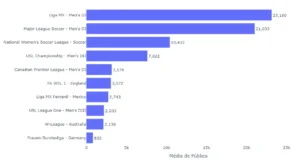
![]()
“ This data highlights the disparity between women’s and men’s soccer, but it also indicates the potential for growth in women’s soccer, especially considering the success of the NWSL. ”

Matthew HanssenData Analysis Specialist
The upward trend in women’s football reflects cultural shifts towards gender equality in the sport, highlighting the need to promote and invest in women’s leagues.
Impact on Women’s Football World Cups
In 2023, the World Cup broke records. There were 2 billion people watching worldwide and almost 2 million in the stadiums. FIFA’s digital platforms had more than 50 million visitors (more than double compared to 2019).
The FIFA Fan Festival, a free event with big screens on the streets of the host country, attracted over 770,000 people. In addition, there were also a lot of goals. There were 163, surpassing the 146 goals scored in the 2015 (Canada) and 2019 (France) World Cups.
The growth in engagement is quite remarkable. The first edition, in China in 1991, attracted 510,000 fans. The following World Cups have seen fluctuations in audiences, a “rollercoaster” ride, but the long-term trend has always been growth.
In the last edition, held in Australia and New Zealand, the number recorded was 1,978,274 people.
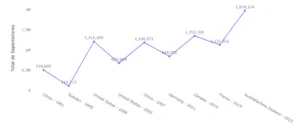
Economic advances and challenges
The evolution of salaries in the NWSL reflects both the challenges and advances in the recognition and appreciation of women’s soccer in the United States.
Since the league’s inception in 2013, there has been significant progress in the salaries paid to female players. Initially, the lowest salary recorded was $6,000 per season, with the highest salary reaching $30,000.
![]()
“ Over the years, the NWSL has seen a gradual increase in both the minimum and maximum wages, reflecting ongoing efforts to improve working conditions and recognize talent in women’s soccer. ”

Matthew HanssenData Analysis Specialist
In 2017, the minimum wage more than doubled from its debut year, marking a major inflection point in wage negotiations. By 2023, the minimum wage had reached $36,400, and the maximum had soared to $200,000.
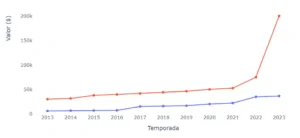
These pay increases not only highlight the growing support for women’s football, but also a greater commitment to equity and sustainability within the sport.
The jump to a $200,000 salary in 2023, in particular, signals a new era of professionalism and recognition for NWSL athletes, fostering greater competitiveness and attracting talent from around the world.
![]()
“ However, there is still a long way to go to achieve full pay parity with men’s leagues, a fight that remains central to the gender equality movement in sport. ”

Matthew HanssenData Analysis Specialist
Conclusion
The rise of women’s football reflects a significant shift not only in the sporting landscape, but also towards greater gender equality and professional recognition.
There has been an impressive evolution of the NWSL, highlighting both audience growth and salary advances for athletes, reaffirming women’s soccer as a globally appreciated and competitive sport.
Through the analysis of different leagues around the world and the trajectory of the Women’s World Cups, the growing interest and investment in women’s football becomes clear.
These advances, however, do not mask the remaining challenges, particularly with regard to pay parity and comparable investment to men’s football.
Still, the progress made so far points to a promising future, where women’s football continues to break barriers, inspire future generations and foster a more equal environment in the sport.
